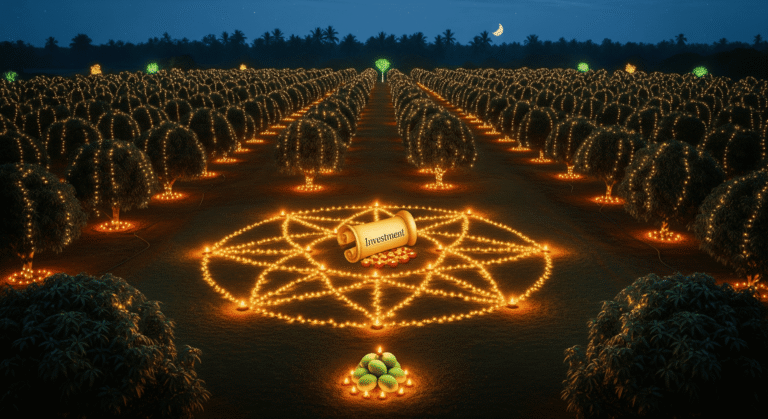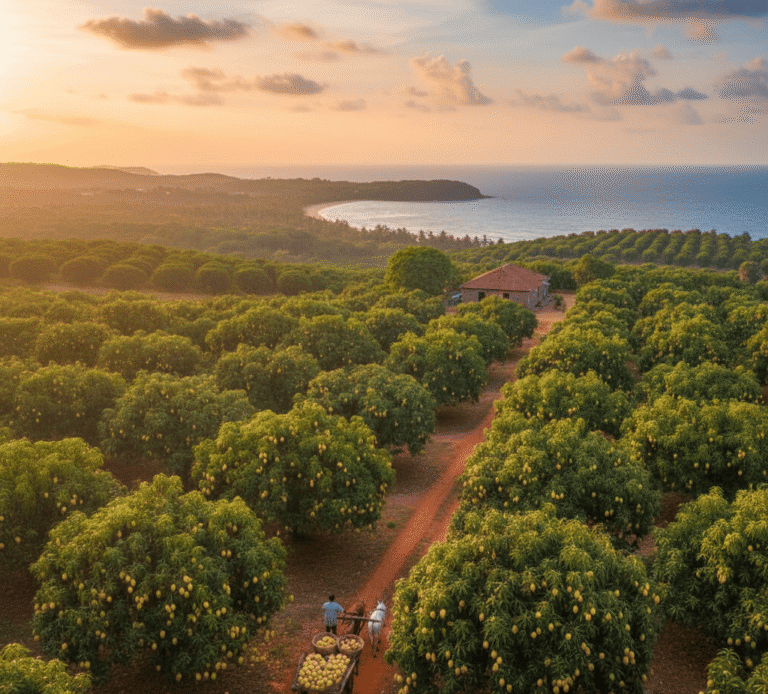Deep within the coastal regions of Karnataka lies a mystical tradition that has captivated audiences for centuries. Bhoota Kola, also known as Bhuta Kola, represents one of India’s most enigmatic folk art forms—a ritualistic theatre that bridges the spiritual and earthly realms through mesmerizing performances under the cover of darkness.
The Cultural Heartland of Tulu Nadu
The coastal stretch of Tulu Nadu, extending from Kerala’s border to Kundapura, encompasses approximately 150 kilometers of culturally rich territory. This region, with Mangalore as its cultural epicenter, serves as the primary stage for Bhoota Kola traditions. Beyond Kundapura, the landscape transitions into Konkan culture, marking a distinct cultural boundary that has preserved the unique identity of Tulu Nadu’s spiritual practices.
The Dakshina Kannada district in Karnataka remains the most active region for these spirit worship ceremonies, where ancient traditions continue to thrive despite rapid modernization. This coastal belt is renowned for its diverse religious sites and vibrant festival celebrations, with Bhoota Kola standing as perhaps the most distinctive among them.
Understanding the Ritual: A Theater of Spirits
Bhoota Kola translates to the worship of lesser-known demons and spirits, representing a complex system of beliefs deeply rooted in the religious sentiments of Tulu Nadu’s inhabitants. This folk art form serves multiple purposes—it functions as spiritual worship, community gathering, social forum, and cultural preservation all rolled into one spectacular nighttime performance.
The ritual typically begins in the late evening and continues until the early hours of dawn, with the climactic Kola dance reaching its crescendo as morning approaches. Spectators often remain throughout the entire night, witnessing the gradual transformation of ordinary individuals into spiritual mediums believed to channel divine entities.
The Visual Spectacle: Colors, Costumes, and Mysticism
Elaborate Face Painting and Symbolism
The most striking aspect of Bhoota Kola lies in its intricate face painting and makeup artistry. Each Daiva (spirit) receives distinct visual treatment through carefully applied colors and patterns that carry deep symbolic meaning.
The eyes are painted entirely black, serving multiple purposes: creating an aura of mystery and fear, concealing the performer’s identity, and facilitating the psychological transformation necessary for spiritual possession. When impersonators view themselves after the makeup application, they often cannot recognize their own features—a crucial element in achieving the trance-like state required for authentic spirit channeling.
The remaining facial areas are painted in vibrant reds and oranges. Red, as a stimulating color associated with energy and power, immediately captures viewers’ attention while symbolizing the fiery nature of the spirits being invoked. These color choices, combined with intricate detailing, create vivid visual appeal that enhances the ritual’s psychological impact on both performers and audiences.
Traditional Costumes and Accessories
Performers don elaborate folk costumes complete with swords, bells, and various ceremonial accessories. These elements combine to create an imposing visual presence that embodies the fierce nature of the spirits being portrayed. The costumes vary depending on the specific Daiva being represented, with each spirit maintaining its unique visual identity through distinct clothing and ornamental choices.
The Spiritual Pantheon: Understanding the Daivas
Bhoota Kola encompasses various types of spirits and deities, each with distinct origins and characteristics:
Categories of Spirits
Totemic Origin Spirits: These represent ancient animistic beliefs connected to natural elements and ancestral worship.
Brahminic Origin Spirits: These depict the fiery attendants of Lord Shiva and Goddess Shakti, known as Ganas, representing the incorporation of Vedic traditions into local practices.
Hero Deification: Many spirits represent regional heroes who achieved martyrdom while defending their communities, subsequently being elevated to divine status through local folklore.
Distinct Spiritual Identities
Each Daiva maintains its own story, background, physical representation, performance style, and musical accompaniment. This diversity ensures that every Bhoota Kola ceremony offers unique experiences depending on which spirits are being invoked during the ritual.
The offerings presented to different spirits also vary significantly based on their origins and characteristics. Puranic spirits typically receive flowers, rice, and bananas, while tribal spirits are offered liquor and meat. Rooster sacrifice, performed by the impersonator, remains a common practice for certain categories of spirits.
Musical and Performance Elements
Paadanas: The Sacred Songs
The ritual incorporates specially composed songs called Paadanas, which are performed as the ceremony begins. These songs often draw from Vedic myths that have been recomposed and adapted to local traditions, creating a bridge between ancient scriptures and regional folklore.
Atmospheric Elements
The entire performance takes place against a backdrop of drum-based music, creating rhythmic foundations that support the dancers’ movements and enhance the trance-inducing atmosphere. Burning bonfires provide illumination, casting dramatic shadows and adding to the mystical ambiance that defines Bhoota Kola.
The combination of high-pitched singing, intense drumming, torch burning, and spectacular feats like leaping over burning coals creates a powerful psychological effect on believers and spectators alike. These elements work together to create an immersive experience that transcends ordinary entertainment.
Cultural Significance and Community Impact
Social Connection and Community Building
Beyond its spiritual dimensions, Bhoota Kola serves as a crucial social institution that strengthens community bonds. These gatherings bring together people from various backgrounds, fostering social connections and maintaining cultural continuity across generations.
The ritual provides a forum for community members to address collective concerns, seek guidance on important matters, and maintain connections with their cultural roots. Through spirit mediumship, communities believe they receive divine guidance and protection for their collective well-being.
Psychological and Cultural Phenomena
The practice represents a fascinating intersection of psychology, spirituality, and cultural expression. The elaborate preparation process, including makeup application and costume donning, facilitates a form of self-hypnotism that enables performers to embody the spirits they represent.
This transformation process demonstrates humanity’s enduring desire for intimate connections with natural and supernatural forces, providing participants with experiences that transcend ordinary consciousness and connect them to deeper spiritual realities.
Resilience in the Modern Era
Despite rapid globalization and technological advancement, Bhoota Kola continues to maintain its relevance and appeal in contemporary Tulu Nadu. The tradition has successfully adapted to modern contexts while preserving its essential spiritual and cultural elements.
The ritual’s persistence demonstrates the deep-rooted nature of these beliefs and their continued importance in the lives of local communities. As both an art form and spiritual practice, Bhoota Kola stands as a testament to the enduring power of traditional culture to provide meaning and connection in an increasingly modernized world.
Experiencing Bhoota Kola: A Transformative Encounter
For visitors and cultural enthusiasts, witnessing a Bhoota Kola ceremony offers a rare glimpse into one of India’s most authentic folk traditions. The experience provides insights into the complex relationship between spirituality, community, and artistic expression that continues to define life in coastal Karnataka.
The ritual’s ability to create profound psychological and spiritual impacts on participants and observers alike makes it a unique cultural phenomenon that deserves recognition and preservation. As traditional practices face challenges from modernization, Bhoota Kola’s continued vitality offers hope for the preservation of India’s diverse cultural heritage.
Conclusion
Bhoota Kola represents more than mere entertainment or religious ritual—it embodies a living tradition that connects communities to their ancestral roots while providing spiritual guidance and social cohesion. Through its combination of visual artistry, musical performance, and spiritual devotion, this folk art form continues to demonstrate the enduring power of traditional culture to enrich human experience.
As one of the most distinctive cultural practices of the Konkan region, Bhoota Kola deserves recognition not only for its artistic merit but also for its role in preserving community identity and spiritual connection in an rapidly changing world. The tradition stands as a powerful reminder of humanity’s enduring need for transcendent experiences that connect us to something greater than ourselves.
For those interested in experiencing this remarkable tradition, Bhoota Kola ceremonies are regularly held throughout the Dakshina Kannada district, offering visitors authentic encounters with one of India’s most captivating folk art forms.


